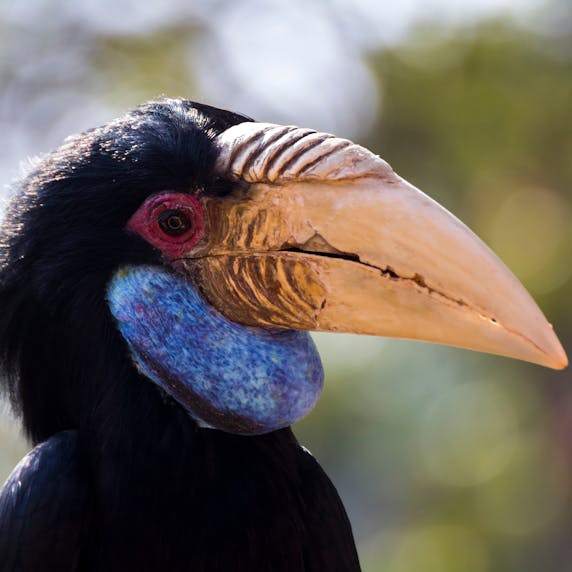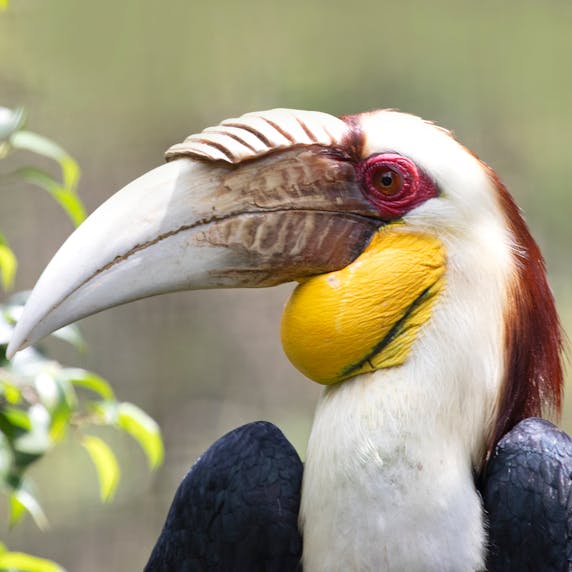
In the dense rain forests of Southeast Asia, colourful hornbills fly among the tall trees. One of these species is the wreathed hornbill, which is characterised by the ribbed horn on its beak. In fact, scientists used to believe that you can tell how old the wreathed hornbill is by the number of ridges on its horn. Rotterdam Zoo is helping to protect this beautiful bird in the wild.
Rhyticeros undulatus

40 years
75 – 85 centimeters
♀ 1.4 – 2.7 kg
♂ 1.6 – 3.6 kg
Wreathed hornbills are rather large birds with black wings and a white tail. The males are recognizable by their light yellow head and bright yellow throat pouch. Young females also have a yellow throat pouch, but after about 2 years, it turns blue. Like other species of hornbill, the wreathed hornbill has a 'horn' on top of its long, curved beak. In the case of the wreathed hornbill, the horn is quite flat and ridged.
Wreathed hornbills are native to Southeast Asia, from India and Bhutan to Vietnam and Indonesia. There, they live in the tall trees of dense tropical rainforests. During the breeding season, they often move into lower areas. The rest of the year they are found mostly in montane rainforests, up to about 2.5 kilometers in altitude.

Wreathed hornbills are true fruit eaters. They consume fruits from more than 30 different types of plants. This makes them very important for the plants in the rainforest, as they help spread the seeds of these plants. They cannot digest these seeds and therefore excrete them whole. Between eating and defecating, hornbills can fly distances of up to 10 kilometers. This way, the seeds end up in new locations, contributing to the diversity of the rainforest.

Wreathed hornbills nest in cavities of old, tall trees, about 18 to 28 meters above the ground. When a pair has found a nesting site, the female enters the cavity and together they seal her inside. They use mud, dung, and fruit peels for this task, protecting the nest from predators. As long as the female is enclosed, the male provides food. He feeds her and the chick through a slit in the nest, which only her beak can fit through. The mother waits to leave the nest until the young hornbill is large enough to fly.

Hornbills, such as the wreathed hornbill, are very dependent on natural rainforests. They tend to stay away from cities and logged forests. This makes them vulnerable, as rainforests in Southeast Asia are rapidly declining. This makes them less likely to find a suitable mate and more likely to come into contact with related animals, increasing the risk of inbreeding. The creation of green ‘corridors’ reconnects these pieces of rainforest and allows forest dwellers to meet each other again. Although these corridors are often built with other endangered species in mind, such as tigers and elephants, we can simultaneously protect these threatened hornbills.
The wreathed hornbills at Rotterdam Zoo have a tall enclosure with many branches to perch on. At the top of their enclosure hangs a barrel where the female can nest. For this purpose, the caretakers specifically lay down clay in the enclosure. This way, the pair can wall the female in when she's going to brood. The hornbills are fed vegetables and fruit. During the breeding season, they also receive beetle larvae to take up enough proteins to lay eggs.

